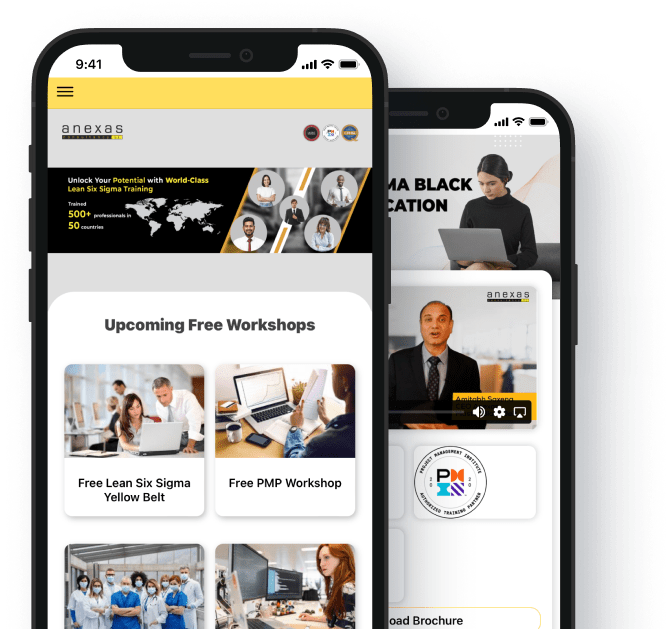Table of Contents
Share This Article
Introduction to Lean Six Sigma: A Beginner’s Guides
- 27916 views
Introduction To Lean Six Sigma
Brief overview of Lean Six Sigma
Lean Six Sigma is a robust methodology that amalgamates the philosophies of Lean and Six Sigma, aiming to enhance processes, minimize waste, and elevate overall organizational performance. While Lean emphasizes value creation by eliminating non-value-added activities and optimizing workflows, Six Sigma prioritizes reducing process variation and defects through meticulous data analysis and statistical techniques. Together, these approaches provide a holistic strategy for continuous improvement, enabling organizations to achieve operational excellence, enhance customer satisfaction, and drive sustainable growth.
Importance and relevance in today’s business environment
In the contemporary business environment, characterized by fierce competition, evolving customer expectations, and the relentless pursuit of operational efficiency, Lean Six Sigma has emerged as a vital tool for organizations seeking to thrive and succeed. By offering a structured framework for identifying improvement opportunities, implementing effective solutions, and measuring outcomes, Lean Six Sigma empowers businesses to adapt, innovate, and continuously improve. Its focus on data-driven decision-making and customer-centricity aligns with the demands of modern enterprises, making it a relevant and indispensable approach for achieving excellence in today’s dynamic marketplace.
Objective of the guide: Providing beginners with a foundational understanding
The primary objective of this guide is to equip beginners with a foundational understanding of Lean Six Sigma, enabling them to navigate its principles, methodologies, and applications with confidence and clarity. By demystifying complex concepts, illustrating practical examples, and providing actionable insights, this guide aims to bridge the knowledge gap and facilitate a smoother learning curve for individuals and organizations embarking on their Lean Six Sigma journey. Whether you are a novice seeking to explore the fundamentals or an experienced professional looking to refresh your knowledge, this guide serves as a valuable resource for unlocking the transformative potential of Lean Six Sigma and driving meaningful improvements in your organization.

What is Lean Six Sigma?
Definition of Lean and Six Sigma
In the intricate tapestry of process improvement methodologies, Lean and Six Sigma emerge as prominent threads, each contributing unique perspectives and tools to enhance organizational performance. Firstly, the “definition of lean” encapsulates a philosophy centered on delivering maximum value to customers through the elimination of waste and inefficiencies. Grounded in foundational principles such as value stream mapping, continuous flow, and Kaizen (continuous improvement), Lean emphasizes optimizing processes to enhance speed, efficiency, and customer satisfaction. Conversely, the “definition of Six Sigma” embodies a data-driven approach aimed at minimizing variability and defects within processes, thereby ensuring consistent quality and performance. By leveraging statistical analysis, structured problem-solving techniques, and the DMAIC (Define, Measure, Analyze, Improve, Control) framework, Six Sigma strives to achieve operational excellence and drive tangible business results.
Integration of Lean and Six Sigma
When exploring the “integration of Lean and Six Sigma,” we witness a powerful synergy that forms the foundation of Lean Six Sigma, a comprehensive methodology designed to maximize value creation and minimize waste while maintaining a focus on quality and data-driven decision-making. This integrated approach harmoniously blends the waste elimination and value-centric principles of Lean with the analytical rigor and process optimization techniques of Six Sigma, creating a holistic framework for continuous improvement and organizational excellence. Professionals keen on mastering this transformative methodology can embark on their journey through resources like “introduction to lean six sigma” guides or leverage digital platforms offering “lean certification online” programs. Moreover, pursuing an “online green belt certification” serves as a strategic investment, equipping individuals with the essential skills and qualifications to apply the “lean six sigma principles” and methodology effectively. However, discerning the “difference between lean and six sigma” is crucial for harnessing their combined strengths and navigating the complexities of implementing Lean Six Sigma initiatives within diverse organizational contexts. By enrolling in accredited programs such as “best six sigma green belt training” and obtaining recognized “lean six sigma qualification,” professionals can unlock unparalleled opportunities for personal and professional growth while optimizing the “lean six sigma cost” and driving sustainable business success.
Origins of Lean (e.g., Toyota Production System)
The origins of Lean trace back to the Toyota Production System (TPS), a groundbreaking approach developed by Toyota in post-World War II Japan. Faced with challenges such as limited resources, volatile markets, and stringent customer demands, Toyota embarked on a transformative journey to redefine manufacturing and operational excellence. The TPS introduced pioneering principles such as Just-in-Time (JIT) production, Jidoka (automation with a human touch), and Kaizen (continuous improvement), laying the groundwork for Lean methodology. By fostering a culture of waste elimination, value creation, and continuous improvement, TPS not only revolutionized Toyota’s operations but also set a new standard for efficiency and excellence that would inspire organizations worldwide to embrace Lean thinking.
Origins of Six Sigma (e.g., Motorola)
The origins of Six Sigma can be attributed to Motorola in the mid-1980s, where engineer Bill Smith pioneered a data-driven approach aimed at enhancing product quality and operational efficiency. Recognizing the need for a systematic methodology to reduce defects and process variability, Smith introduced Six Sigma, drawing inspiration from statistical quality control methods and quality management practices. Central to the Six Sigma methodology is the DMAIC (Define, Measure, Analyze, Improve, Control) framework, which provides a structured approach to problem-solving and process improvement. By emphasizing rigorous statistical analysis, root cause identification, and continuous measurement and monitoring, Motorola’s Six Sigma initiative yielded remarkable results, fueling widespread adoption across industries and laying the foundation for the modern Six Sigma movement.
Lean Principles (e.g., Value, Flow, Pull)
The foundational “lean principles,” such as Value, Flow, and Pull, serve as the cornerstone of the Lean methodology, guiding organizations on their journey to operational excellence and waste elimination. The principle of Value emphasizes understanding and delivering what truly matters to customers, thereby aligning organizational processes and activities with customer needs and expectations. Flow focuses on optimizing workflow and eliminating bottlenecks to ensure smooth and efficient operations, enabling organizations to respond quickly to changing demands and market conditions. Lastly, Pull emphasizes creating a responsive system where production is driven by actual customer demand, thereby minimizing inventory and reducing lead times. By embracing these core principles, organizations can enhance efficiency, improve customer satisfaction, and create a culture of continuous improvement, making them essential components of any “introduction to lean six sigma” initiative or “lean certification online” program. Professionals seeking to deepen their understanding of these principles can benefit from resources like “lean six sigma online” courses and “online green belt certification” programs, which offer comprehensive training and practical insights into implementing lean principles effectively. However, it’s crucial to recognize the “difference between lean and six sigma” and tailor approaches accordingly to leverage the unique strengths and methodologies of each discipline. By investing in “best six sigma green belt training” and obtaining recognized “lean six sigma qualification,” individuals can acquire the necessary skills and credentials to drive lean initiatives, optimize the “lean six sigma cost,” and contribute to organizational success.
Six Sigma Principles (e.g., Data-Driven Decision Making, Process Variation)
The “Six Sigma principles” encompass a data-driven approach to process improvement and performance optimization, emphasizing the importance of statistical analysis, process control, and continuous measurement. Central to Six Sigma is the principle of Data-Driven Decision Making, which advocates for making informed decisions based on empirical evidence and rigorous analysis rather than intuition or anecdotal evidence. By employing statistical tools and methodologies, organizations can identify root causes of defects, measure process performance, and develop effective solutions to achieve desired outcomes. Another critical principle is Process Variation, which emphasizes understanding and minimizing variability in processes to ensure consistent and predictable results. By controlling and reducing variation, organizations can enhance product quality, improve customer satisfaction, and achieve operational excellence. Professionals keen on mastering Six Sigma principles can explore resources such as “lean six sigma online” courses and “online green belt certification” programs, which provide comprehensive training on Six Sigma methodologies, tools, and practices. However, integrating these principles into broader process improvement initiatives requires a nuanced understanding of the “difference between lean and six sigma” and the ability to leverage their combined strengths effectively. By investing in “best six sigma green belt training” and obtaining a recognized “lean six sigma qualification,” individuals can acquire the skills and expertise to drive Six Sigma initiatives, optimize the “lean six sigma cost,” and contribute to organizational success through data-driven decision-making and process optimization.

Key Concepts and Terminology
Value vs. Waste
- Defining value from the customer’s perspective: One of the fundamental “lean six sigma principles” revolves around defining value from the customer’s perspective, a principle deeply rooted in understanding and aligning organizational processes with customer needs and expectations. In the context of Lean Six Sigma, value is defined as any activity or process that directly contributes to meeting customer requirements and enhancing customer satisfaction. By adopting a customer-centric approach, organizations can prioritize resources and efforts on activities that add value and eliminate those that do not, thereby optimizing performance and delivering superior products or services. This principle underscores the importance of aligning organizational goals and activities with customer needs, a concept that is central to any “introduction to lean six sigma” initiative or “lean certification online” program. Professionals seeking to deepen their understanding of this principle can benefit from resources like “lean six sigma online” courses and “online green belt certification” programs, which offer comprehensive training and practical insights into implementing lean principles effectively. However, to leverage this principle successfully, it is essential to recognize the “difference between lean and six sigma” and integrate their methodologies and tools in a cohesive manner. By investing in “best six sigma green belt training” and obtaining a recognized “lean six sigma qualification,” individuals can acquire the necessary skills and credentials to drive customer-centric initiatives, optimize the “lean six sigma cost,” and foster a culture of continuous improvement and value creation within their organizations.
- Identifying and categorizing waste (e.g., Overproduction, Waiting, Defects): In the realm of Lean Six Sigma, identifying and categorizing waste is a crucial practice that aligns with the core principle of maximizing value and minimizing inefficiencies. Waste, in this context, refers to any activity or process that does not add value from the customer’s perspective, thereby consuming resources without contributing to the desired outcome. Common types of waste, such as Overproduction, Waiting, and Defects, can significantly impact organizational performance, customer satisfaction, and profitability. By systematically identifying and categorizing waste, organizations can develop targeted strategies to eliminate or mitigate these inefficiencies, thereby optimizing processes and enhancing value creation. This practice is integral to the “lean six sigma methodology” and serves as a cornerstone for continuous improvement and operational excellence. Professionals keen on mastering this practice can explore resources such as “lean six sigma online” courses and “online green belt certification” programs, which provide comprehensive training on lean principles, waste identification techniques, and process optimization strategies. However, integrating waste reduction initiatives into broader process improvement efforts requires a nuanced understanding of the “difference between lean and six sigma” and the ability to leverage their combined strengths effectively. By investing in “best six sigma green belt training” and obtaining a recognized “lean six sigma qualification,” individuals can acquire the skills and expertise to drive waste elimination initiatives, optimize the “lean six sigma cost,” and contribute to organizational success through streamlined processes and enhanced value delivery.
Process Improvement
- DMAIC Methodology (Define, Measure, Analyze, Improve, Control): The DMAIC methodology, encompassing the Define, Measure, Analyze, Improve, and Control stages, serves as a foundational framework within the “lean six sigma methodology,” guiding organizations through structured problem-solving and process improvement initiatives. The Define phase focuses on clarifying project objectives, scope, and deliverables, ensuring alignment with organizational goals and customer requirements. Subsequently, the Measure phase involves quantifying current process performance, identifying key performance indicators (KPIs), and establishing baseline metrics to assess improvement opportunities effectively. In the Analyze phase, organizations delve deeper into root cause analysis, data analysis, and process mapping, aiming to uncover underlying issues and inefficiencies that impact performance. The Improve phase emphasizes developing and implementing targeted solutions, leveraging tools and techniques such as process mapping and value stream mapping to streamline workflows and enhance value delivery. Finally, the Control phase focuses on sustaining improvements by establishing monitoring mechanisms, developing standard operating procedures, and continuously measuring performance against established KPIs. Professionals eager to master the DMAIC methodology can explore resources like “lean six sigma online” courses and “online green belt certification” programs, which provide comprehensive training and practical insights into applying DMAIC principles effectively. By investing in “best six sigma green belt training” and obtaining a recognized “lean six sigma qualification,” individuals can acquire the skills and expertise to drive DMAIC projects, optimize the “lean six sigma cost,” and contribute to organizational success through systematic process improvement and performance optimization.
- Tools and Techniques (e.g., Process Mapping, Root Cause Analysis): A plethora of tools and techniques, ranging from process mapping and root cause analysis to statistical analysis and hypothesis testing, are integral to the “lean six sigma methodology,” providing practitioners with the necessary resources to identify, analyze, and solve complex problems effectively. Process mapping, for instance, enables organizations to visualize workflows, identify bottlenecks, and streamline operations, while root cause analysis techniques facilitate a deeper understanding of underlying issues and inefficiencies. Statistical tools, such as control charts and regression analysis, empower organizations to analyze data, measure process performance, and make informed decisions based on empirical evidence. By mastering these tools and techniques, practitioners can enhance their problem-solving capabilities, optimize processes, and drive continuous improvement initiatives within their organizations. For professionals seeking to expand their toolkit, resources like “lean six sigma online” courses and “online green belt certification” programs offer comprehensive training on various tools and techniques, equipping individuals with the skills and knowledge to apply them effectively in real-world scenarios. By investing in “best six sigma green belt training” and obtaining a recognized “lean six sigma qualification,” individuals can enhance their professional credentials, contribute to organizational success, and optimize the “lean six sigma cost” through informed decision-making and data-driven problem-solving.
Performance Matrices
- Key Performance Indicators (KPIs): Key Performance Indicators (KPIs) serve as vital navigational tools within the realm of “lean six sigma methodology,” offering organizations a structured approach to aligning performance metrics with overarching strategic objectives. KPIs provide quantifiable benchmarks that enable leaders and practitioners to monitor progress, evaluate success, and drive continuous improvement across various facets of the organization. Whether focusing on operational efficiency, customer satisfaction, financial performance, or quality assurance, the strategic selection and deployment of KPIs foster a culture of accountability, transparency, and data-driven decision-making. By establishing clear performance targets and aligning metrics with organizational goals and customer expectations, KPIs empower organizations to optimize resource allocation, identify improvement opportunities, and enhance value delivery. Professionals keen on mastering the art and science of KPI development and implementation can leverage resources such as “lean six sigma online” courses and “online green belt certification” programs, which offer comprehensive training and practical insights into leveraging KPIs to drive organizational success. By investing in “best six sigma green belt training” and obtaining a recognized “lean six sigma qualification,” individuals can enhance their proficiency in KPI management, contribute to performance optimization initiatives, and align organizational efforts with strategic objectives to achieve sustainable growth and excellence.
- Metrics for measuring process performance and improvement: In the pursuit of operational excellence and continuous improvement, the effective measurement of process performance and improvement stands as a cornerstone within the “lean six sigma methodology.” By leveraging a diverse array of quantitative and qualitative metrics, organizations can gain invaluable insights into the efficiency, effectiveness, and value delivery of their processes, enabling informed decision-making and targeted improvement initiatives. Metrics such as cycle time, throughput, defect rate, and customer satisfaction scores provide tangible indicators of process health, highlighting areas of strength and opportunities for optimization. By systematically measuring, analyzing, and interpreting these metrics, organizations can identify root causes of inefficiencies, implement targeted solutions, and monitor the impact of improvement initiatives over time. For professionals seeking to deepen their expertise in process measurement and improvement, resources like “lean six sigma online” courses and “online green belt certification” programs offer comprehensive training and practical guidance on selecting, implementing, and analyzing performance metrics effectively. By investing in “best six sigma green belt training” and obtaining a recognized “lean six sigma qualification,” individuals can acquire the necessary skills and knowledge to drive process improvement initiatives, optimize performance, and foster a culture of continuous improvement and excellence within their organizations.
Benefits of Lean Six Sigma
The adoption and integration of Lean Six Sigma principles and methodologies offer organizations a transformative pathway to achieve operational excellence, drive continuous improvement, and foster a culture of performance excellence. The multifaceted benefits of Lean Six Sigma span across various dimensions of organizational performance, including operational efficiency, customer satisfaction, and financial impact, positioning it as a cornerstone of modern business excellence frameworks. By embracing Lean Six Sigma, organizations can optimize processes, enhance value delivery, and achieve sustainable growth, thereby gaining a competitive edge in today’s dynamic and competitive marketplace.
Operational Efficiency:
The emphasis on streamlining processes within the Lean Six Sigma framework empowers organizations to eliminate redundancies, standardize workflows, and optimize value delivery across the entire value chain. By applying systematic process improvement techniques and leveraging data-driven insights, organizations can enhance process reliability, reduce variability, and ensure consistent quality, thereby fostering a culture of excellence and continuous improvement. The streamlined processes enable organizations to respond more effectively to customer demands, adapt to market changes, and capitalize on emerging opportunities, positioning them for long-term success and sustainability.
- Streamlining processes: The emphasis on streamlining processes within the Lean Six Sigma framework empowers organizations to eliminate redundancies, standardize workflows, and optimize value delivery across the entire value chain. By applying systematic process improvement techniques and leveraging data-driven insights, organizations can enhance process reliability, reduce variability, and ensure consistent quality, thereby fostering a culture of excellence and continuous improvement. The streamlined processes enable organizations to respond more effectively to customer demands, adapt to market changes, and capitalize on emerging opportunities, positioning them for long-term success and sustainability.
- Reducing waste and variability: A core tenet of Lean Six Sigma is the relentless focus on reducing waste and variability within organizational processes, thereby maximizing value creation and minimizing inefficiencies. By applying tools and techniques such as root cause analysis, statistical process control, and mistake-proofing, organizations can identify, quantify, and eliminate various forms of waste, including overproduction, waiting, defects, and excess inventory. The reduction in waste and variability not only enhances operational efficiency but also improves resource utilization, reduces costs, and enhances customer satisfaction, thereby driving organizational performance and competitiveness.
Customer Satisfaction:
Customer satisfaction stands as a pivotal benefit of Lean Six Sigma, emphasizing the importance of understanding and exceeding customer expectations to build loyalty and drive growth. By applying customer-centric principles and methodologies, organizations can gain insights into customer needs, preferences, and pain points, thereby enhancing product and service quality, responsiveness, and overall customer experience. The relentless focus on customer satisfaction fosters loyalty, drives repeat business, and enhances brand reputation, positioning organizations to achieve sustainable growth and long-term success in today’s competitive marketplace.
Financial Impact
The financial impact of Lean Six Sigma initiatives extends beyond operational efficiency and customer satisfaction, encompassing tangible benefits such as cost reduction, savings, and a significant return on investment (ROI). By eliminating waste, reducing variability, and enhancing productivity, organizations can achieve substantial cost savings, optimize resource allocation, and enhance profitability. The measurable ROI of Lean Six Sigma initiatives underscores its value proposition, enabling organizations to justify investments, secure executive buy-in, and drive continuous improvement as a strategic imperative. Ultimately, the financial impact of Lean Six Sigma contributes to organizational resilience, competitiveness, and long-term sustainability, positioning it as a cornerstone of modern business excellence and performance optimization.

Getting Started with Lean Six Sigma
Assessment and Readiness
Evaluating organizational readiness for Lean Six Sigma
Assessing organizational readiness for Lean Six Sigma implementation is a critical first step in embarking on the journey towards operational excellence and continuous improvement. Evaluating readiness involves a comprehensive assessment of organizational culture, leadership commitment, existing processes, and resource availability to ensure alignment with Lean Six Sigma principles and methodologies. By conducting a thorough readiness assessment, organizations can identify potential barriers, challenges, and opportunities, thereby developing a tailored implementation strategy that aligns with their unique needs and objectives. Professionals and leaders responsible for spearheading Lean Six Sigma initiatives can leverage resources such as “lean certification online” courses and “online green belt certification” programs to gain insights into best practices, assessment frameworks, and strategies for evaluating organizational readiness effectively. By investing in “best six sigma green belt training” and obtaining a recognized “lean six sigma qualification,” individuals can acquire the necessary skills and expertise to conduct comprehensive readiness assessments, develop targeted implementation plans, and drive successful Lean Six Sigma initiatives that deliver tangible results and sustainable impact.
Identifying areas for improvement and potential projects
Once organizational readiness has been assessed and established, the next crucial step in the Lean Six Sigma journey involves identifying areas for improvement and potential projects that align with strategic objectives and customer needs. This process involves a systematic analysis of existing processes, performance metrics, customer feedback, and market trends to uncover inefficiencies, bottlenecks, and opportunities for optimization. By applying Lean Six Sigma tools and methodologies, such as process mapping, value stream mapping, and root cause analysis, organizations can gain actionable insights into areas that require attention, thereby prioritizing improvement initiatives and allocating resources effectively. The identification of potential projects involves a collaborative and cross-functional approach, engaging stakeholders, subject matter experts, and frontline employees to ensure alignment, buy-in, and commitment to driving change and fostering a culture of continuous improvement. Professionals keen on mastering the art of project identification and prioritization can explore resources such as “lean six sigma online” courses and “online green belt certification” programs, which offer comprehensive training and practical insights into leveraging data-driven analysis and stakeholder engagement to identify high-impact improvement projects. By investing in “best six sigma green belt training” and obtaining a recognized “lean six sigma qualification,” individuals can enhance their proficiency in project identification, prioritization, and execution, thereby contributing to organizational success and achieving measurable results in alignment with Lean Six Sigma principles and methodologies.
Training and Certification
Overview of training programs and certifications
Training programs and certifications play a pivotal role in equipping professionals with the requisite knowledge, skills, and competencies to drive Lean Six Sigma initiatives effectively. An “introduction to lean six sigma” underscores the importance of structured learning pathways that provide comprehensive coverage of Lean Six Sigma principles, methodologies, tools, and best practices. Organizations and individuals seeking to enhance their proficiency in Lean Six Sigma can explore a myriad of training programs and certifications tailored to various skill levels and roles, ranging from foundational “lean certification online” courses to advanced “online green belt certification” and “best six sigma green belt training” programs. These training initiatives offer a blend of theoretical knowledge, practical insights, and hands-on experience, enabling participants to acquire a deep understanding of Lean Six Sigma concepts and their application in real-world scenarios. By investing in continuous learning and professional development through reputable training providers, individuals can obtain recognized “lean six sigma qualification,” enhance their career prospects, and contribute to organizational success by driving impactful improvement initiatives aligned with Lean Six Sigma principles and methodologies.
Importance of ongoing learning and professional development
The importance of ongoing learning and professional development in the realm of Lean Six Sigma cannot be overstated, given the dynamic nature of today’s business landscape and the evolving complexities of organizational challenges. Embracing a culture of continuous improvement and lifelong learning enables individuals and organizations to stay abreast of emerging trends, best practices, and innovative methodologies, thereby fostering adaptability, resilience, and competitive advantage. As the “difference between lean and six sigma” continues to blur with integrated approaches gaining traction, professionals must remain agile and responsive, continually updating their skills and knowledge to drive value and achieve sustainable results. Resources such as “lean six sigma online” courses, advanced certification programs, and professional networking opportunities offer avenues for ongoing learning, collaboration, and knowledge sharing among practitioners, thought leaders, and industry experts. By embracing the ethos of continuous improvement and investing in professional development, individuals can enhance their expertise, broaden their horizons, and make meaningful contributions to organizational success, thereby reinforcing Lean Six Sigma’s position as a cornerstone of modern business excellence and performance optimization.
Initial Projects and Implementation
Selecting pilot projects for initial implementation
The selection of pilot projects for initial implementation stands as a pivotal phase in the Lean Six Sigma journey, offering organizations an opportunity to validate methodologies, test hypotheses, and demonstrate tangible results in a controlled environment. The strategic selection of pilot projects involves a rigorous assessment of various factors, including organizational priorities, resource availability, stakeholder engagement, and potential impact on key performance indicators. By leveraging data-driven analysis, process mapping, and stakeholder input, organizations can identify high-impact areas that align with strategic objectives, present manageable complexities, and offer opportunities for rapid learning and improvement. The selected pilot projects serve as catalysts for change, enabling organizations to build momentum, gain buy-in from key stakeholders, and foster a culture of continuous improvement. As organizations embark on this phase, resources such as “lean six sigma online” courses, “online green belt certification” programs, and expert consultation provide invaluable guidance, best practices, and tools to ensure successful project selection and implementation. By investing time and effort in selecting pilot projects judiciously, organizations can lay a solid foundation for broader Lean Six Sigma deployment, achieve quick wins, and demonstrate the potential for transformative change, thereby accelerating the journey towards operational excellence and sustainable growth.
Establishing project teams and setting objectives
The establishment of project teams and setting clear objectives stands as a cornerstone of successful Lean Six Sigma initiatives, fostering collaboration, clarity, and alignment across various stakeholders. Assembling cross-functional project teams comprising individuals with diverse expertise, perspectives, and skills enables organizations to leverage collective intelligence, drive innovation, and navigate complex challenges effectively. By defining clear objectives, scope, and deliverables, organizations can ensure that project teams remain focused, aligned, and accountable throughout the implementation process. The establishment of project governance structures, communication protocols, and performance metrics further enhances transparency, facilitates decision-making, and fosters a culture of accountability and continuous improvement. Resources such as “lean certification online” courses, “best six sigma green belt training” programs, and mentorship opportunities offer invaluable insights, methodologies, and best practices to guide organizations in establishing robust project teams and setting SMART objectives aligned with strategic priorities and customer needs. By investing in building cohesive project teams and defining clear objectives, organizations can enhance project success rates, optimize resource utilization, and drive measurable improvements in performance, thereby reinforcing the value proposition of Lean Six Sigma as a catalyst for organizational excellence and sustainable success.
Conclusion
In wrapping up this introduction to Lean Six Sigma, it becomes clear that this methodology offers a transformative approach to operational excellence and continuous improvement. By blending the principles of Lean and Six Sigma, organizations can systematically identify inefficiencies, reduce waste, and enhance value delivery, ultimately driving sustainable growth and customer satisfaction. As businesses navigate the complexities of today’s marketplace, embracing Lean Six Sigma principles provides a strategic roadmap for optimizing processes, fostering innovation, and achieving organizational excellence. Whether you’re a seasoned professional or new to the world of process improvement, embarking on the Lean Six Sigma journey offers a pathway to unlocking new opportunities, enhancing performance, and securing a competitive edge in today’s dynamic business landscape.
FAQ
What is Lean Six Sigma, and how does it differ from traditional Six Sigma?
Understand the fundamentals of Lean Six Sigma and its distinction from the traditional Six Sigma methodology.
Why is Lean Six Sigma relevant in today’s business environment?
Explore the importance and applicability of Lean Six Sigma principles in modern business settings.
What are the key objectives of this beginner’s guide to Lean Six Sigma?
Gain insights into the goals and objectives that this guide aims to achieve for beginners.
How can Lean Six Sigma benefit organizations in terms of efficiency and cost reduction?
Learn about the operational and financial advantages organizations can gain through Lean Six Sigma practices.
Is Lean Six Sigma only applicable to manufacturing, or can it be used in service industries as well?
Understand the versatility of Lean Six Sigma and its application beyond manufacturing, including in service industries.
What are the foundational principles of Lean Six Sigma, and how do they contribute to process improvement?
Explore the core principles of Lean Six Sigma and how they drive continuous improvement in processes.
Are there online certification options for Lean Six Sigma, and how can beginners get started?
Learn about available online certification programs in Anexas and the initial steps for beginners interested in Lean Six Sigma.
Can Lean Six Sigma be implemented in small businesses, or is it more suitable for larger organizations?
Understand the scalability of Lean Six Sigma and its applicability in both small and large business environments.
What are the primary differences between Lean and Six Sigma, and how are they integrated in Lean Six Sigma?
Differentiate between Lean and Six Sigma methodologies and understand how they synergize in Lean Six Sigma.
What resources and tools are recommended for beginners starting their Lean Six Sigma journey?
Explore the essential resources and tools that beginners can leverage to initiate their learning and implementation of Lean Six Sigma.






